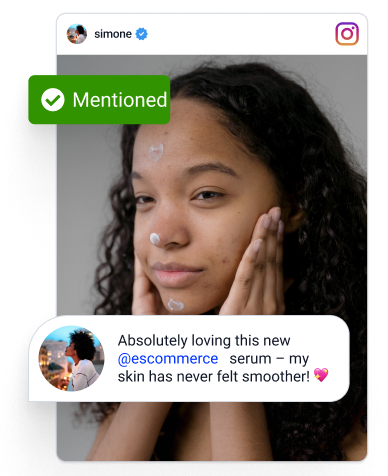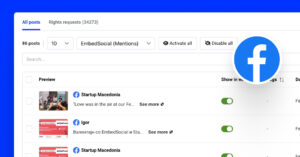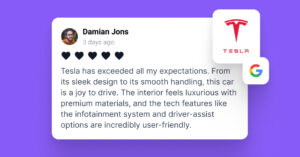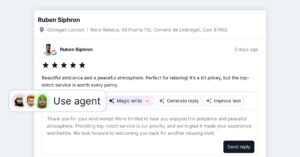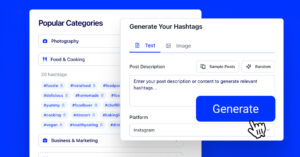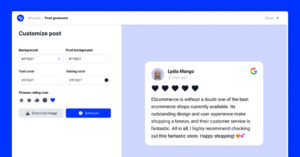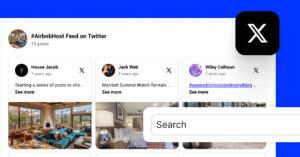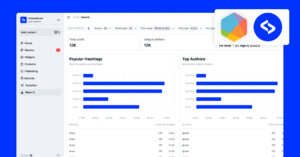Les spécialistes du marketing raffolent des données ! Après tout, les meilleures décisions que vous puissiez prendre sont basées sur des données pertinentes concernant votre consommateur cible et vos concurrents !
C'est ici que écoute sociale vient surveiller les conversations pertinentes sur votre marque, votre secteur d'activité ou vos concurrents afin d'en tirer des enseignements et d'améliorer vos stratégies.
Vous devez commencer à examiner les contenu généré par l'utilisateur créés à la fois par d'autres marques et par votre public cible, car ils offrent d'innombrables possibilités d'apprentissage.
Vous voulez savoir ce que vous faites de bien, ce que vous pouvez améliorer, ce que les consommateurs pensent de vos produits et services et ce qui les touche ?
Alors, continuez à lire, car je vais vous dire tout ce qu'il y a à savoir sur le social listening !
Qu'est-ce que l'écoute sociale ?
L'écoute sociale, c'est comme écouter les conversations sur votre marque-mais d'une manière totalement éthique et intelligente. Il s'agit de suivre ce que les gens disent de votre entreprise, de vos concurrents et de votre secteur d'activité sur les réseaux sociaux et d'autres plateformes.
Signification de "Social listening" (écoute sociale)
Mais c'est bien plus que cela, car l'écoute sociale va plus loin : elle vous aide à comprendre ce qui se passe dans la société. pourquoi les gens disent ce qu'ils font sur vos produits et vos concurrents.
Considérez-le comme un moyen de prendre le pouls de votre public et d'utiliser ces connaissances pour prendre de meilleures décisions, établir des relations plus solides et même obtenir des résultats. preuve sociale.
Lorsqu'elle est bien menée, l'écoute des médias sociaux vous aide :
- Découvrez les messages marketing qui touchent la corde sensible de votre public ;
- Découvrez les nouveaux défis et les points douloureux auxquels vos clients sont confrontés ;
- Explorez les sujets et les centres d'intérêt qui captivent votre clientèle ;
- Identifier des stratégies pour donner à votre entreprise un avantage sur ses concurrents ;
- Repérez les occasions d'engager des conversations avec votre public.
Vous avez besoin du social listening si vous voulez savoir qui est votre public cible, ce qu'il veut, comment il s'engage avec vous et pourquoi il aime ou n'aime pas vos produits.
Social listening vs social monitoring
Bien qu'ils soient utilisés de manière interchangeable, l'écoute sociale et la surveillance sociale sont des activités qui ne sont pas nécessairement liées à des questions de sécurité. différents!
Surveillance sociale s'appuie sur des données telles que les mentions de la marque et les des hashtags uniques pour la marque pour vous montrer ce que les gens disent exactement sur les médias sociaux. D'autre part, écoute sociale va au-delà des chiffres pour décrire le sentiment général à l'égard de votre marque et de vos concurrents.
Ainsi, si la veille sociale signifie la collecte d'informations à court termeL'écoute sociale est une stratégie à long terme pour l'analyse des données et d'en tirer des enseignements.
Voici un bref aperçu des deux concepts et de leurs différences :

Exemple : Imaginons que Coca-Cola lance un nouveau parfum et suive le hashtag #NewCokeFlavor. Le suivi social montrerait combien de personnes ont mentionné le hashtag et si la réaction a été positive ou négative.
L'écoute sociale, en revanche, permet d'analyser les sentiments profonds qui se cachent derrière ces mentions - les clients sont-ils enthousiasmés par la saveur, suggèrent-ils des ajustements ou la comparent-ils à un produit concurrent comme Pepsi ?
Ces informations pourraient aider Coca-Cola à ajuster sa stratégie de marketing ou même à modifier le produit en fonction des réactions du public.
Lire la suite :
6 raisons pour lesquelles l'écoute sociale est importante pour les marques
Pourquoi l'écoute sociale est-elle plus qu'un simple mot à la mode dans le domaine du marketing ? Lorsqu'elle est bien menée, elle change la donne pour n'importe quelle marque, et ce pour plusieurs raisons :

- Comprendre votre public de manière plus approfondie-L'écoute sociale vous permet d'aller au-delà des données démographiques de surface pour découvrir ce qui préoccupe vraiment vos clients, leurs points de douleur, ce qu'ils pensent de votre marque et comment ils réagissent à vos messages. campagnes de marketing;
- Garder une longueur d'avance sur les concurrents-en surveillant les conversations sur vos concurrents, vous pouvez identifier leurs faiblesses, tirer des enseignements de leurs réussites et trouver des moyens de les surpasser ;
- Prévenir les crises potentielles de relations publiques-La détection précoce des conversations négatives peut vous aider à résoudre les problèmes avant qu'ils ne s'aggravent, protégeant ainsi votre entreprise. réputation dans les médias sociaux;
- Façonner vos offres de produits ou de services-L'écoute des commentaires, qu'ils soient bons ou mauvais, vous permet de savoir ce que veulent les clients, ce qui vous aide à affiner votre offre ;
- Élaborer de meilleures stratégies de marketing-comprendre les messages qui résonnent le plus auprès de votre public pour créer des campagnes qui font mouche à chaque fois ;
- Identifier les tendances et les opportunités émergentes-être à l'écoute du terrain permet d'identifier tendances des médias sociaux et saisissez les occasions de faire participer votre public.
En intégrant l'écoute sociale à votre stratégie, vous ne vous contentez pas de surveiller les conversations sociales, vous construisez une marque qui écoute, évolue et prospère.
Comment créer une stratégie d'écoute sociale efficace ?
Alors, comment créer une stratégie d'écoute sociale efficace ? Il y a plusieurs étapes à suivre pour maximiser votre temps et vos efforts :

1. Fixer des objectifs clairs
Point: Ancrez votre stratégie en définissant un objectif commercial clair derrière vos efforts d'écoute sociale.
Preuves:
🍿 Lorsque McDonald's a remarqué la tendance virale du Grimace Shake sur TikTok, elle a été en mesure de s'engager rapidement avec un contenu ludique et conforme à la marque. Ce n'est pas le fruit du hasard, mais le résultat d'objectifs de suivi clairs liés à la détection des tendances en temps réel.
Expliquer:
Commencez par identifier les objectifs que vous souhaitez atteindre grâce à l'écoute sociale. C'est ce qui déterminera l'ensemble de votre approche.
Répartissez vos objectifs dans des catégories telles que
- Sentiment de marqueLes clients sont-ils satisfaits, confus, frustrés ou fidèles ?
- Suivi des concurrents-Que disent les gens des marques ou produits concurrents ?
- Détection des tendances-Quelles sont les nouvelles conversations ou les changements culturels qui émergent ?
Connaître votre "pourquoi" vous permet de cibler vos outils, de filtrer vos mots-clés et d'interpréter les bonnes données lorsque cela compte le plus.
✅ Notez vos 3 principaux objectifs d'écoute sociale - chacun d'entre eux doit être lié à une action ou une mesure potentielle (par exemple, améliorer le sentiment, augmenter la part de voix, affiner le message).
2. Choisir les bons outils d'écoute sociale
Point: Choisissez une plateforme qui correspond à vos objectifs, et pas seulement à votre budget.
Preuves:
🛠️ Poppi a utilisé EmbedSocial pour suivre plus de 500 posts générés par des influenceurs pendant sa campagne $800K, en analysant le sentiment et l'UGC pour évaluer ce qui a résonné et ce qui a raté la cible.
Expliquer:
Les bons outils ne se contentent pas de suivre les mentions : ils interprètent les émotions, cartographient les modèles d'engagement et font ressortir les tendances. Pensez à des outils tels que :
- EmbedSocial-pour le suivi des UGC, les mentions de marques multi-locales et les widgets intégrables ;
- Sprout Social-pour une gestion complète des médias sociaux ;
- Talkwalker-pour l'analyse des sentiments à l'échelle mondiale et l'évaluation comparative de la concurrence.
Si votre objectif est de collecter des CGU à partir des médias sociaux et de les afficher sur votre site web, vous aurez besoin d'une plateforme qui prenne en charge l'agrégation et la réutilisation.
Assurez-vous que votre outil offre des filtres par plateforme, par segment d'audience et par zone géographique afin d'obtenir des informations plus ciblées.
Pour plus d'options de plateformes, consultez notre tour d'horizon des les meilleurs outils de suivi des médias sociaux pour comparer les caractéristiques.
✅ Testez au moins deux outils et évaluez dans quelle mesure ils correspondent à vos objectifs d'écoute.
3. Se concentrer sur les plateformes qui comptent
Point: Donnez la priorité aux plateformes où votre public parle réellement de vous.
Preuves:
📸 Pendant la semaine de la mode à Paris, plus de 4 000 des plus de 6 500 posts suivis étaient basés sur du texte et principalement sur X (Twitter), ce qui montre que se concentrer uniquement sur Instagram aurait manqué des informations clés.
Expliquer:
Il n'est pas nécessaire de suivre toutes les plateformes sociales. Concentrez-vous sur :
- Instagram et TikTok pour les marques B2C et UGC ;
- LinkedIn pour des discussions B2B et professionnelles ;
- X (Twitter) & Reddit pour obtenir des commentaires sur les tendances et un retour d'information en temps réel.
Laissez le comportement de votre public - et non des suppositions - guider votre écoute.
✅ Vérifiez vos indicateurs d'engagement actuels pour identifier les plateformes les plus performantes avant de commencer à écouter.
4. Définissez vos mots-clés et vos thèmes
Point: Utilisez un ciblage intelligent des mots clés pour éviter les bruits non pertinents et vous concentrer sur les informations qui comptent.
Preuves:
🔍 Nike utilise l'écoute sociale pour surveiller des termes tels que "chaussures durables" et "équipement écologique", ce qui lui permet de repérer les tendances et d'affiner les messages sur les produits pour les clients soucieux de l'environnement.
Expliquer:
Répertoriez les mots-clés en quatre catégories :
- Conditions de la marque-EmbedSocial", "Embed Social", "Embed widget" ;
- Noms et caractéristiques des produits-Instagram UGC", "review widgets" ;
- Mentions des concurrents-rivaux directs ou alternatives indirectes ;
- Termes et tendances de l'industrie-comme la "preuve sociale" ou les "vols bon marché".
Utilisez des variantes, des fautes d'orthographe et des formes de hashtag pour élargir la couverture, mais filtrez de manière agressive pour rester pertinent.
✅ Constituez votre banque de mots-clés et vérifiez chaque mois sa pertinence et ses performances.
5. Créer des alertes et automatiser le suivi
Point: Utilisez l'automatisation pour rester réactif sans vous noyer dans les données.
Preuves:
🔔 Chipotle a mis en place des alertes en temps réel pour répondre aux mentions de "guac gratuit" pendant les campagnes, ce qui a entraîné un engagement rapide et une amélioration des scores de sentiment.
Expliquer:
La plupart des outils vous permettent de configurer :
- Alertes en temps réelpour les mentions clés ou les mots-clés de crise tels que "mauvais service" ;
- Digests quotidiens/hebdomadaires-pour un contrôle continu ;
- Filtres intelligents-pour exclure les spams ou les mentions hors sujet.
Veillez à ce que les alertes soient ciblées et significatives afin d'éviter la "lassitude".
✅ Commencez par 3 à 5 termes d'alerte prioritaires et développez-les si nécessaire.
6. Analyser les données de manière approfondie
Point: Aller au-delà des mentions brutes pour identifier les tendances, les modèles et les opportunités.
Preuves:
📊 Après le lancement d'un produit, Starbucks a suivi les pics de sentiments négatifs liés au "temps d'attente" et a rapidement ajouté du personnel aux heures de pointe, réduisant ainsi les plaintes de 40%.
Expliquer:
Regardez :
- SentimentLes mentions sont-elles positives, négatives ou neutres ?
- ModèlesLes problèmes apparaissent-ils après les campagnes, les lancements ou les mises à jour ?
- Thèmes-Quels sont les sujets qui dominent les conversations (par exemple, le prix, la livraison, la conception) ?
Le contexte est important - le volume seul ne suffit pas à rendre compte de la situation.
✅ Créez un résumé hebdomadaire des informations qui comprend les principaux sentiments, les thèmes et les actions possibles. Par exemple, si vous remarquez une plainte récurrente concernant les délais d'expédition, cette commentaires des clients peut devenir un outil puissant pour améliorer les opérations.
7. Agir sur ce que vous apprenez
Point: L'écoute sociale ne sert à rien si elle ne conduit pas à des décisions.
Preuves:
🌱 Ben & Jerry's a utilisé les retours d'écoute sociale pour lancer de nouvelles saveurs à base de plantes, en alignant l'innovation produit sur la demande du public.
Expliquer:
Utiliser les données pour :
- Adapter la messagerie-Si un slogan ne vous convient pas, testez un nouveau texte ;
- Affiner les produitsSi les utilisateurs font l'éloge d'une fonctionnalité spécifique, mettez-la en évidence ;
- S'engager directement-Remerciez les défenseurs, répondez aux plaintes ou demandez plus d'informations.
Considérez l'écoute sociale comme votre laboratoire de recherche sur les utilisateurs en temps réel.
✅ Créez une série de contenus "Vous avez dit / Nous avons fait" pour montrer aux clients que vous les écoutez.
8. Mesurez votre succès
Point: Suivre des indicateurs qui reflètent les progrès réels, et pas seulement l'activité.
Preuves:
📈 Après avoir lancé une campagne axée sur le sentiment, Spotify a suivi une augmentation de 15% de la part de voix par rapport à Apple Music sur X et Instagram.
Expliquer:
Utilisez des mesures telles que
- Score de sentimentLa perception s'améliore-t-elle ?
- Volume d'engagementLes gens parlent-ils davantage de vous ?
- La part de voixComment vos mentions se comparent-elles à celles de vos concurrents ?
L'une des meilleures mesures pour évaluer la présence de votre marque est la suivante La part de voix-le nombre de fois où l'on parle de vous par rapport à vos concurrents.
La plupart des outils proposent également des statistiques avancées telles que les impressions, les clics, la portée ou les taux d'engagement.
✅ Établissez une base de référence avant de lancer des campagnes afin de mesurer l'impact réel.
9. Affiner et répéter
Point: L'écoute sociale n'est jamais "prête à l'emploi".
Preuves:
♻️ Duolingo a transféré davantage d'efforts d'écoute sur TikTok lorsque l'engagement de la génération Z a grimpé en flèche, en s'assurant que leur stratégie correspondait au comportement de l'audience.
Expliquer:
Réexaminez votre stratégie tous les trimestres :
- Passez en revue vos objectifsSont-ils toujours alignés sur les priorités de l'entreprise ?
- Mettez à jour vos mots-clésQu'est-ce qui est encore pertinent ? Qu'est-ce qui ne l'est plus ?
- Explorer de nouvelles plateformes-Ne négligez pas Reddit, YouTube Shorts ou Threads.
L'écoute sociale est itérative. Votre marque, votre public et vos plates-formes évoluent - votre stratégie doit en faire autant.
Si vous êtes prêt à mettre en œuvre ces étapes, La solution d'écoute sociale d'EmbedSocial réunit le tout avec des fonctions UGC intégrées.
✅ Planifiez un audit d'écoute trimestriel afin d'évaluer les performances et de rafraîchir votre approche.
Conseil de pro : après la collecte des données, intégrer des mentions sur Instagram et Facebook sur votre site web pour mettre en valeur les CGU et favoriser les conversions.
Quel outil d'écoute des médias sociaux choisir ?
Une étape essentielle de la création et de la mise en œuvre d'une stratégie d'écoute sociale consiste à utiliser les bons outils d'écoute sociale. outils d'écoute socialeet EmbedSocial est l'un des meilleurs :

En tant que numéro 1 Plate-forme UGC et agrégateur de médias sociauxEmbedSocial collecte, gère et affiche le contenu de toutes les plateformes de médias sociaux.
Toutefois, en plus de intégrer des messages dans les médias sociaux sur vos sites web, il offre de nombreuses fonctionnalités d'écoute sociale.
Pour commencer, vous pouvez suivre les hashtags et les mentions sur plusieurs sites, langues et régions et filtrer tous les messages pertinents sur les médias sociaux.
Mais ce n'est pas tout ! Voici tous les avantages de l'écoute sociale :
- Agrégation de CGU-collecte et affiche automatiquement du contenu provenant de diverses plateformes de médias sociaux dans le cadre de la campagne de sensibilisation de l'opinion publique. widgets de site web intégrables pour renforcer votre crédibilité ;
- Conseil de pro : Vous pouvez compléter vos stratégies de social listening Instagram et de social listening Facebook avec des widgets de site web sur mesure.
- Contrôle en temps réelsuivre instantanément les mentions de la marque, les hashtags et les mots-clés sur plusieurs canaux, ce qui permet de répondre rapidement aux commentaires des clients et aux tendances émergentes ;
- Analyse des sentiments-évaluer le ton des conversations en ligne pour comprendre la perception du public et prendre des décisions éclairées afin d'améliorer la satisfaction des clients ;
- Rapports personnalisables-Générer des rapports analytiques détaillés adaptés à vos besoins spécifiques, facilitant les stratégies basées sur les données et démontrant le retour sur investissement ;
- Intégration transparente-s'intègrent facilement à vos outils et flux de travail marketing existants, garantissant une approche cohérente de la gestion des médias sociaux.
Comme vous pouvez le constater, en plus d'être une puissante outil de gestion des médias sociauxAvec EmbedSocial, vous pouvez tirer parti des fonctionnalités robustes d'EmbedSocial pour surveiller efficacement votre public et vous engager avec lui, en transformant les informations en actions impactantes qui stimulent la croissance de la marque.
Vous n'avez pas besoin de vous engager puisqu'il existe une version gratuite et une version à prix réduit. Essai gratuit de 7 jours de la $29 par mois Le niveau payant est le plus élevé. Cela dit, il existe des niveaux supérieurs avec des fonctionnalités avancées, comme le PRO Plus ($49/mois), le Premium ($99/mois), et un plan d'entreprise personnalisé.
Conseils pour optimiser votre stratégie d'écoute sociale
Il est essentiel d'affiner votre approche de l'écoute sociale à mesure que les tendances et les outils évoluent. Voici des conseils clés pour garantir l'efficacité de votre stratégie en 2025 :

- Tirer parti de l'IA et des outils d'automatisation-Utilisez des fonctions alimentées par l'IA, telles que l'analyse des sentiments et les informations prédictives, pour une interprétation plus rapide et plus précise des données ;
- Élargir votre écoute à des plateformes de niche-surveiller les plateformes émergentes telles que TikTok ou Reddit pour découvrir les tendances que les concurrents pourraient manquer ;
- Suivre le sentiment, et pas seulement les mentions-se concentrer sur ce que les gens pensent de votre marque afin de repérer les points à améliorer ou de tirer parti d'un engouement positif ;
- Segmentez votre public pour obtenir de meilleures informations-Filtrez les données d'écoute sociale en fonction des données démographiques ou des régions pour adapter votre stratégie aux besoins spécifiques de votre public ;
- Engagez-vous directement auprès de votre public-répondre aux commentaires en ligne et les mentions pour renforcer les liens et montrer que votre marque est à l'écoute ;
- Réviser régulièrement votre stratégierevoir vos objectifs, vos mots-clés et vos outils tous les trimestres pour vous adapter à l'évolution des tendances.
L'optimisation de votre stratégie d'écoute sociale vous permettra de garder une longueur d'avance et de vous assurer que vos efforts continuent à produire des résultats significatifs.
Comment faire de l'écoute sociale avec un outil : 3 exemples concrets
Pour vous montrer ce que L'outil d'écoute des médias sociaux piloté par l'IA d'EmbedSocial Je l'ai utilisé pour analyser trois événements viraux dans les médias sociaux :
1. La campagne virale "Mort du duo
Lorsque Duolingo a lancé son énigmatique opération "Death of Duo", l'internet a explosé de théories, de mèmes et de débats. Pour en comprendre tout l'impact, nous avons réalisé un analyse du sentiment et de l'engagement sur 1 336 messages en utilisant le tableau de bord d'EmbedSocial :
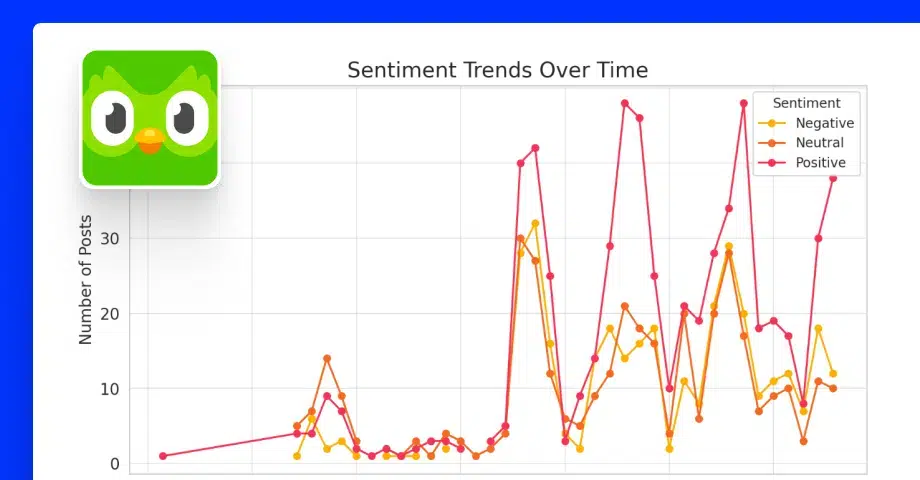
Ce que les données ont révélé :
- Le texte a régné en maître-Plus de 60% des posts étaient textuels, tandis que les mèmes et les vidéos de courte durée amplifiaient l'engagement.
- Principaux hashtags et contributeurs-Des hashtags comme #DeathOfDuo et #JusticeForDuo ont fait un bond, mais près de la moitié des messages n'en utilisaient aucun, ce qui met en évidence un potentiel de portée non atteint.
- Ventilation du sentiment-L'humour a dominé les réactions positives, tandis que la confusion et l'inquiétude ont alimenté les réactions négatives.
À retenir :
Les cascades virales comportent des risques. L'écoute sociale a non seulement montré comment la campagne de Duolingo a attiré l'attention, mais elle a également mis en évidence l'importance de clarifier le message de la marque sur toutes les plateformes afin d'éviter les malentendus.
2. La cascade d'influence de Poppi ($800K)
Poppi, la marque de soda prébiotique, a fait preuve d'audace avec une campagne d'influence à gros budget - en envoyant des distributeurs automatiques complets à des créateurs sélectionnés. En utilisant EmbedSocial, nous avons suivi et analyse de plus de 500 messages pour comprendre l'accueil réservé par le public à la campagne et les leçons à en tirer pour les futurs spécialistes du marketing :
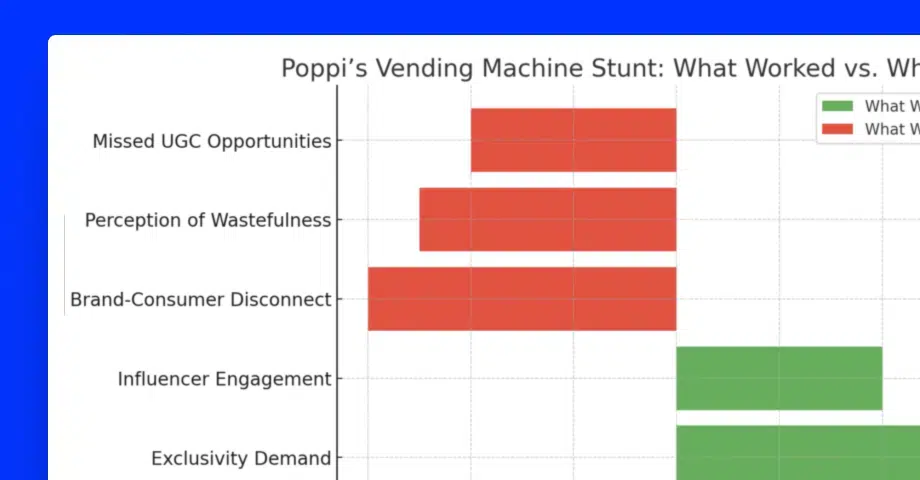
Principales conclusions de l'analyse :
- Répartition des sentiments-Si beaucoup ont salué la créativité de la cascade et son alignement sur des événements de la culture pop tels que le Super Bowl, d'autres l'ont critiquée pour son manque de nuance ou son caractère excluant.
- Regroupement de sujets-Les discussions ont permis de relier la campagne à des conversations culturelles plus larges, notamment Taylor Swift, les Eagles et la viralité de l'UGC.
- Ce qui a fonctionné-Le spectacle physique a suscité l'engouement, l'alignement des influenceurs a porté ses fruits et la marque a atteint un pic de visibilité.
- Ce qui n'a pas été fait-Poppi a risqué de s'aliéner les clients de tous les jours en favorisant les macro-influenceurs et a manqué des opportunités de CGU plus profondes en n'incluant pas les fans de base.
À retenir :
Un outil d'écoute sociale comme EmbedSocial fait apparaître les applaudissements et les réactions négatives, fournissant ainsi une feuille de route pour des campagnes plus inclusives et axées sur la communauté à l'avenir.
3. Semaine de la mode à Paris
Pour savoir comment les utilisateurs ont réagi à l'un des plus grands événements du monde de la mode, nous avons a analysé plus de 6 500 messages autour de #ParisFashionWeek et #PFW. Notre objectif ? Comprendre comment la conversation s'est déroulée et ce que les marques peuvent apprendre du comportement du public :
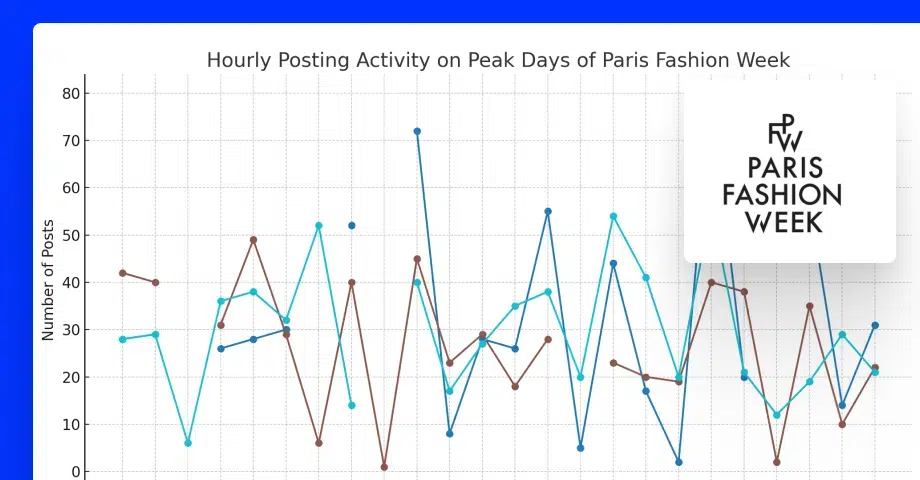
Principales conclusions du rapport d'écoute :
- Conversations textuelles-Plus de 4 000 messages étaient textuels, ce qui laisse entrevoir un potentiel inexploité en matière de contenu vidéo et de carrousel.
- Pics spécifiques à l'événement-L'engagement s'est intensifié les jours de grands défilés, mettant en évidence les possibilités de publication de contenu en temps réel.
- Ventilation du sentiment d'appartenance à la marque-Chanel, Valentino, Dior et Louis Vuitton ont tous bénéficié de mentions majoritairement positives, bien que certaines marques soient à la traîne en termes de volume d'engagement.
- Mots-clés émergents-Les participants ont parlé de luxe, de tendances émergentes et d'exclusivité, offrant ainsi aux spécialistes du marketing une mine d'or de contenu pour les campagnes de la saison prochaine.
À retenir :
La Semaine de la mode de Paris n'est pas seulement un événement de défilé, c'est aussi un moment de narration numérique. Le social listening a permis de révéler quelles marques ont été à la hauteur de l'événement et lesquelles ont encore de la marge pour optimiser leurs stratégies UGC.
Comment les grandes marques utilisent-elles le social listening à des fins de marketing ?
Même les plus grandes marques s'appuient sur le social listening pour tirer parti des dernières tendances virales, notamment les suivantes :
McDonald's : S'engager dans les tendances virales
McDonald's excelle dans l'utilisation de l'écoute des médias sociaux pour surveiller les tendances virales et s'y engager. Un exemple notable est sa réponse à la tendance 2023 Grimace Shake sur TikTok.
- Situation: Après avoir lancé le Grimace Shake dans le cadre d'une campagne promotionnelle, McDonald's a constaté une augmentation du contenu généré par les utilisateurs sur TikTok, où les clients ont créé des vidéos humoristiques et parfois étranges mettant en scène le shake.
- Action: En écoutant activement les conversations sur les médias sociaux, McDonald's a identifié cette tendance et a choisi de s'engager de manière ludique. L'entreprise a publié un mème indiquant : "Je fais semblant de ne pas voir la tendance des milk-shakes à la grimace" : "Je fais semblant de ne pas voir la tendance à la grimace", montrant ainsi qu'ils sont conscients de la situation et qu'ils ont le sens de l'humour.
- Résultats: Cet engagement a amplifié la tendance, conduisant à une visibilité accrue de la marque et à des interactions positives avec les clients sur de multiples plateformes.
Nike : Comprendre les préférences des clients
Nike utilise l'écoute sociale pour mieux connaître les préférences de ses clients et les tendances émergentes, ce qui lui permet d'adapter efficacement ses stratégies de marketing.
- Situation: En surveillant les discussions sur les médias sociaux, Nike a identifié un intérêt croissant pour les produits durables et respectueux de l'environnement parmi son public cible.
- Action: En s'appuyant sur ces informations, Nike a élargi sa gamme de chaussures et de vêtements durables, en promouvant ces produits par le biais de campagnes ciblées dans les médias sociaux qui ont trouvé un écho auprès des consommateurs soucieux de l'environnement.
- Résultats: Cette approche a permis de renforcer l'image de marque de Nike en tant que leader en matière de développement durable et d'accroître l'engagement auprès d'un segment de clientèle clé.
Starbucks : Naviguer dans les crises de réputation
Starbucks utilise souvent l'écoute des médias sociaux pour gérer la réputation de sa marque en ligne et répondre rapidement aux crises potentielles.
- Situation: En 2018, dans un magasin de Philadelphie, deux hommes noirs ont été arrêtés alors qu'ils attendaient un ami, ce qui a suscité de nombreuses réactions sur les réseaux sociaux au sujet du profilage racial.
- Action: Grâce à une écoute sociale vigilante, Starbucks a rapidement pris conscience de la situation et du sentiment négatif qui en a découlé. L'entreprise a réagi en présentant des excuses publiques, en fermant ses magasins dans tout le pays pour suivre une formation sur les préjugés raciaux et en s'engageant directement auprès des personnes concernées.
- Résultats: La réponse rapide et complète de Starbucks a permis d'atténuer la crise, démontrant l'engagement de l'entreprise à traiter les questions sociales et à maintenir la confiance des clients.
Ces exemples illustrent la manière dont les marques peuvent tirer parti de l'écoute des médias sociaux pour s'engager dans les tendances, comprendre les préférences des clients, et gérer leur réputation en ligne.
Conclusion : Commencez dès aujourd'hui à faire de l'écoute sociale pour élever votre marque !
Quel que soit votre secteur d'activité, des idées d'affaires fructueuses naissent lorsque vous comprenez parfaitement vos clients, leurs besoins et leurs problèmes.
L'écoute sociale est le meilleur moyen d'y parvenir, car elle vous permet d'obtenir des opinions brutes et spontanées de la part de vos clients.
En outre, vous bénéficiez de nombreux autres avantages, tels que l'avance sur vos concurrents, la prévention des crises de relations publiques et la fourniture de produits et de services améliorés.
Pour économiser un temps précieux, de l'argent et des efforts en écoutant vos clients, vous avez besoin des bons outils, tels que EmbedSocial-fournit des informations sur vos produits et vos concurrents, et crée des images captivantes de votre entreprise. flux de médias sociaux!
Qu'attendez-vous ? Commencez à créer votre stratégie d'écoute sociale dès aujourd'hui !
FAQ sur l'écoute sociale
Qu'entendez-vous par écoute sociale ?
L'écoute sociale est le processus de surveillance des conversations en ligne sur votre marque, vos concurrents ou votre secteur d'activité afin de comprendre le sentiment du public, d'identifier les tendances et d'obtenir des informations exploitables pour améliorer les stratégies.
Qu'est-ce qu'un outil d'écoute sociale ?
Les outils d'écoute sociale sont des solutions logicielles qui suivent, analysent et rendent compte des conversations en ligne sur votre marque, vos concurrents ou votre secteur d'activité, vous aidant ainsi à découvrir des informations, à surveiller les sentiments et à prendre des décisions stratégiques.
Quel est un exemple d'écoute des médias sociaux ?
Un exemple d'écoute des médias sociaux est celui de Starbucks qui surveille les mentions sur Twitter de sa nouvelle boisson de vacances. En analysant le sentiment de ces mentions, la marque peut évaluer les réactions des clients, traiter les plaintes et affiner sa stratégie de marketing.
Comment l'écoute des médias sociaux peut-elle accroître la fidélisation des clients ?
En identifiant les clients satisfaits qui parlent organiquement de votre marque, vous pouvez les transformer en défenseurs. Répondez à leurs messages, mettez-les en avant dans vos campagnes UGC et engagez-les dans des programmes de fidélisation ou d'affiliation. L'écoute vous permet de saisir ces moments en temps réel et de les amplifier avec un minimum d'efforts.
Comment savoir par quels réseaux sociaux commencer pour faire du social listening ?
Commencez là où vos clients sont les plus actifs. Pour la plupart des marques, il s'agit d'Instagram, de X (anciennement Twitter) et de YouTube. Regardez où vous obtenez le plus de mentions, de commentaires ou de hashtags. Concentrez votre écoute sur ces canaux dans un premier temps, puis élargissez-la en fonction des nouvelles tendances ou campagnes.
Quels sont les trois types d'écoute sociale ?
Les trois types d'écoute sociale sont les suivants :
Écoute sociale combinée-en combinant l'écoute spécifique à une marque et l'écoute de l'ensemble du secteur pour obtenir une vue d'ensemble des conversations et des opportunités.
Écoute sociale de base-en se concentrant sur le suivi des mentions de la marque et des réactions directes des clients pour contrôler la présence en ligne ;
Écoute sociale approfondie-analyser les tendances générales du secteur, les activités des concurrents et le sentiment du public afin de découvrir des informations stratégiques ;
Comment l'écoute sociale peut-elle aider un spécialiste du marketing ?
L'écoute sociale aide les spécialistes du marketing à comprendre ce que le public dit de leur marque, de leurs concurrents et de leur secteur d'activité en temps réel. Il révèle les tendances émergentes, les sentiments des clients et les opportunités de contenu afin d'améliorer les campagnes et les stratégies de produits.
Comment mesurer l'écoute sociale ?
L'écoute sociale est mesurée à l'aide d'indicateurs clés tels que :
Notoriété de la marque-Le degré de reconnaissance de votre marque est mesuré par la portée.
Score de sentiment-le rapport entre les mentions positives, négatives et neutres de votre marque ;
Part de voix-la fréquence à laquelle votre marque est mentionnée par rapport à celle de vos concurrents ;
Taux d'engagement-les interactions telles que les likes, les commentaires et les partages sur le contenu suivi ;
Atteindre-la taille de l'audience potentielle exposée à des mentions de votre marque ;
Taux de conversion-le nombre de prospects ou de ventes générés grâce à l'écoute sociale ;
Quelle est la différence entre le social listening et le social monitoring ?
Voici la principale différence entre le social listening et le social monitoring :
Surveillance sociale suivre les mentions directes, les tags ou les commentaires sur votre marque (ce qui est dit).
Écoute sociale s'intéresse aux conversations, aux tendances et aux sentiments plus larges, même lorsque votre marque n'est pas mentionnée (pourquoi on en parle).
Utilisez le suivi pour un engagement en temps réel et l'écoute pour orienter la stratégie.
Comment la surveillance des médias sociaux peut-elle informer vos équipes de vente et de produits ?
Le suivi révèle ce que les clients disent de vos produits, de vos concurrents et de leurs problèmes. Les équipes de vente peuvent s'en servir pour obtenir des informations sur les prospects ou traiter les objections. Les équipes produits peuvent découvrir les demandes de fonctionnalités, les bogues ou les cas d'utilisation les plus courants, directement auprès des utilisateurs réels.
Quelles sont les mesures importantes en matière d'écoute sociale ?
Les principales mesures comprennent l'analyse du sentiment, le volume des mentions, l'engagement sur les mentions, les principaux mots-clés et la part de voix. Suivez l'évolution de ces éléments dans le temps pour voir comment la perception de la marque évolue.
Pourquoi devriez-vous ajouter les fautes d'orthographe courantes de votre nom de marque à vos mots-clés d'écoute sociale ?
En incluant les fautes d'orthographe courantes du nom de votre marque, vous vous assurez de capturer toutes les mentions pertinentes, même lorsque les utilisateurs font des fautes de frappe. Vous éviterez ainsi de passer à côté de commentaires, de questions ou de crises potentielles.
